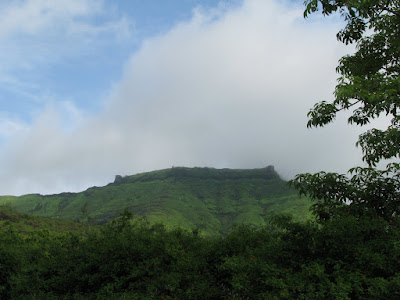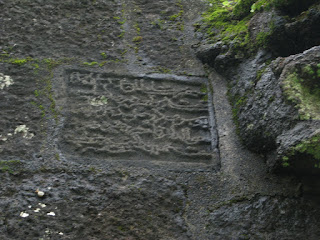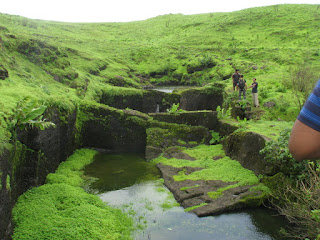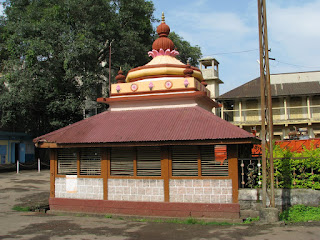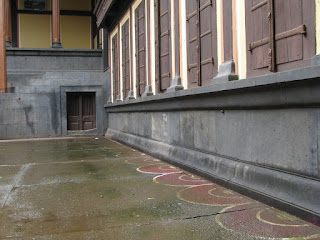Welcome. In this post, we will relive the exciting trek from Khandala to Duke's Nose (also called Nagphani). This trek is so popular amongst trekkers, that Khandala station wears the look of a crowded marketplace on weekends during rainy season.
Location and getting there:
View Forts in a larger map
Trek
In mid July, the monsoon is at its peak And entire region wears green. Hence there is a strong desire to go out and do some physical activity. We need a break from our routine. This is the best time.
This trek was "all are welcome" trek. It was like a social gathering. No prior booking required. We just need to reach the railway station before a given timing and board the train.
We started from Pune by 6:30 AM express to Mumbai. This train stops at Khandala. The entire train was full from Pune itself. Several trekkers from different groups were standing. At last, we reached Khandala a little over an hour. The entire Khandala station was full of trekkers from different groups. There were about 180 plus participants in our group. The leaders gathered us on one of the platforms. They had arranged a tea vendor dedicatedly for the group for that time. There were 4-5 boxes of patties to be distributed to the participants as breakfast. Soon enough, we had our breakfast on the platform. The leaders counted participants. We set out to begin the trek.
It was raining all throughout. So no question about getting wet. Most of us had jackets or other rain wear. For some distance, we walked along an abandoned railway track. Then we left the railway track and proceeded from below a huge pipeline. Next we entered an enclave of villas. As soon as this small enclave was left, the scene changed drastically. We were entering an area covered by short bushes. No longer could we walk side by side. After walking like this for a few minutes, we came to a small open area. All of us grouped here before resumed our journey. The path again entered in thick bushes. It was difficult to know direction. It was raining constantly. Water was flowing everywhere.
At last, after circumventing a mountain, we came to one waterfall/stream. The stream was flowing down in 3-4 steps. There was crowd already enjoying the waterfall. It was difficult to move ahead. And without crossing the waterfall, the road ahead could not be traversed. Our group also enjoyed some time in the waterfall.
One accident happened (almost). On seeing the crowd enjoying in the waterfall, two elderly gentlemen could not resist. One of them lost balance and due to the force of the water, started floating with the water. Two persons were standing a couple of feet away. They held him somehow. In the skirmish, the other gentleman lost his balance. Somehow the situation recovered. We should be careful when enjoying. Otherwise it can result in accident and spoil the fun. Soon another group came on the spot. They fixed rope for crossing. Now there was almost no space for even standing. Our group moved on.
Soon there was steep ascent. It led us to the top of the mountain through thick jungle. Now we were seeing that we were on a mountain with deep valley on the side. Everything was lush green. The trees were tall. After some more gradual ascent, we came to one rock patch. The patch was small. But there were no holds. And the rain did not help our cause. Our leaders ensured that we climbed this patch. After some traverse, we reached another patch. This was easier. On one side of the traverse, there was deep valley. After negotiating this patch, we came on the top of Duke's Nose. We had started almost four and a half hours back from Khandala railway station. It was 1:30 PM by now. It was constantly raining. There was fog. The visibility was very low.
 |
After having our lunch, we started our return journey. The return journey was swift. Only initial phase had steep decline. Later there was an unpaved path which directly takes us to Kurawande village. In Kurawande village, we saw one snake gliding through the water. We saw one Large Egret standing majestically in one of the fields. It was unperturbed by the rain. If only, it was not raining, it would have been in a thousand photographs! We generally do not see Egrets of that size. From here, it was straight road to Lonavala. The entire walk was uneventful. By 5:00 PM, we were back on Lonavala. There were several bungalows on our way. Most of them weekend homes of persons staying in Mumbai or Pune. The main roads in Lonavala were overcrowded.
As it was raining heavily, water was flowing everywhere. At one place, somebody had inserted two leaves to make it easier to collect the water.
A local took us back to Pune by 8:00 PM.




